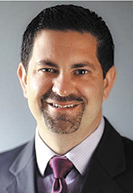Subscriber Benefit
As a subscriber you can listen to articles at work, in the car, or while you work out. Subscribe NowThe science behind insurance is far from new. Actuarial tables were developed centuries ago, leading to an industry whose core business model has remained relatively stable as times change.
But what happens when technology threatens to not only disrupt the market, but completely reshape it? This is the question facing insurance industry experts as “Insurtech” — a portmanteau of the words “insurance” and “technology” — continues to rise.
Regulation vs. innovation
It’s a challenge firms such as Frost Brown Todd are looking to tackle head on. Last month, the firm hosted InsuranceConnect at Bankers Life Fieldhouse in Indianapolis, bringing together experts to discuss the promise and challenges inherent in Insurtech.
One of the moderators at the event was Frost Brown Todd attorney Matt Schantz, who, before his legal career, worked for a time at the National Security Agency.
He said with the advent of large-scale data collection, it’s now possible to write insurance policies calculated on an individual’s own risk rather than relying on statistics from large populations.
He said one of the hurdles to implementing these changes, though, was the “balkanized” nature of the industry. There are different regulations in each state, and they generally require data to be submitted in advance before an insurance product is sold.
“(It) doesn’t really work with the new model,” he said. “Letting an insurance company adapt their prices to the actual risk that individuals present ahead of time, that makes for an efficient market.”
 Mitchell
MitchellGreg Mitchell is the chair of Frost Brown Todd’s insurance industry group. He said the Midwest — and Indiana in particular — could be a testing ground for such modernization.
“If we allow the regulation over top that would make sense” then there would be an “opportunity kind of in a safe harbor to make adjustments (to) allow innovation,” he said. “It would also allow (for) a better form of regulation.”
For its part, the National Association of Insurance Commissioners formed the Innovation and Technology Taskforce in late 2016. According to an NAIC spokesperson, the group was meeting regularly to address these concerns.
“Consumers are demanding it,” an NAIC spokesman said in an email. “Our job is to be sure it’s done the right way and compliant with regulatory requirements that are there for the protection of consumers.”
Telematics devices
One of the most visible emerging technologies in the Insurtech field are telematics devices. Auto insurance carriers have been making a concerted effort in recent years to offer usage-based insurance.
A device can be plugged directly into a vehicle’s OBD-II (on-board diagnostics) port. A smartphone app also can be used. Everything from where, when and how you drive can be captured and transmitted using this technology.
Progressive Insurance’s program is known as Snapshot. Liberty Mutual Insurance offers Onboard Advisor for commercial customers. (Both companies refused requests for an interview.)
 Herndon
HerndonAllstate Insurance’s program is known as Drivewise and began in 2010. Justin Herndon, media relations manager, said OBD-II devices were first used, but now anyone who joins does so through the company’s mobile app.
The information from the smartphone’s accelerometer is conveyed and gives customers tips and a varying degree of savings on their bills depending on how well they drive. A new percentage is calculated every six months based on these figures.
The app, Herndon said, is “like you would use for any kind of health app … (It’s) able to pick up hard braking, which (is) based on an algorithm.”
What’s hiding in your algorithm?
These advances promise improved customer service, but what if the algorithms get it wrong?
 Kosnoff
KosnoffFaegre Baker Daniels partner Scott Kosnoff said these formulas, when presented with skewed calculations, can perpetuate very human stereotypes.
“Algorithms that are developed with the best of intentions can still go astray for insurers that are using them,” he said. “Let’s say there’s something in your algorithm that is unintentionally discriminatory. It’s not just being discriminatory on a one-off basis, it’s being discriminatory in a systemic way. … Every application, say, that gets churned through the algorithm is going to (be) subject to the same problem.”
Bose McKinney & Evans partner Brian Jones said the maxim of “garbage in, garbage out” certainly applies to these calculations.
 Jones
Jones“We have the computing power,” he said. “That’s not really the question. It’s do we have the right models, and do we have a sufficient amount of reliable information?”
Kosnoff said this meant insurers would have to be proactive about addressing legal challenges before they arise in practice.
“Insurers really ought to be considering independent testing and validation of their data and algorithms to identify any problems before they come home to roost,” he said.
What’s next?
Ice Miller partner Nicholas Reuhs said he is concerned that fine-slicing the risk pools in this way can have unintended consequences for those most in need.
“The whole idea of insurance is pricing based on a collective risk,” he said. “The better you can predict how likely it is that somebody is going to actually get sick, all of a sudden the people that actually need insurance get priced out of the market.”
Reuhs said he could foresee a future where a building wouldn’t be able to be insured unless it had internet-connected devices installed throughout to detect temperature to avoid threats such as broken pipes.
 Williams
Williams“Maybe this forces premiums down if only because it causes less events to occur,” he said.
Bill Williams is another member of Frost Brown Todd’s insurance industry group who previously worked for United Healthcare for more than 20 years. He said he was excited about the promise of this technology, but with breaches such as those at Target, Equifax and Anthem dominating the headlines, this massive amount of data being collected would have to be carefully guarded going forward.
“You’ve probably got to have a really strong encryption on the application or the device,” he said. “Whether it’s a tablet, a smartphone, a computer that you’re using, it can’t be easily broken into because that really is important.”•
Please enable JavaScript to view this content.

